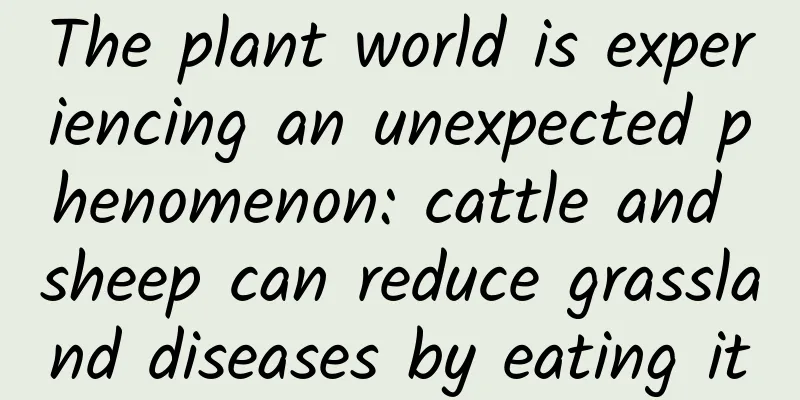The plant world is experiencing an unexpected phenomenon: cattle and sheep can reduce grassland diseases by eating it

|
Produced by: Science Popularization China Produced by: Zhao Xumao (Young Researcher, Lanzhou University) Producer: Computer Network Information Center, Chinese Academy of Sciences From plague and smallpox to SARS and COVID-19, human history is almost a history of dealing with infectious diseases. While humans continue to fight pathogens, plants are also bravely fighting pathogens on another front. Not only that, the health of plants is closely related to human life, health, production and life. When plants get sick, humans can't escape it either. Crop diseases directly affect food production and endanger human survival. Historically, the Irish used to eat potatoes as their staple food. In 1845-1846, a potato late blight caused by Phytophthora infestans (a pathogenic oomycete) swept through Ireland's main grain-producing areas. Within just a few months, hundreds of thousands of people starved to death and millions were displaced, fleeing to the European continent and North America. Not only that, plant diseases occurring in natural ecosystems can also cause harm to humans. China has 6 billion mu of grassland, which accounts for 41% of the country's land area and is more than three times the current arable land area in my country. Most of these grasslands are used to develop animal husbandry, grazing hundreds of millions of cattle and sheep, directly providing humans with various meat and dairy products. Leaves are the most important photosynthetic organs of plants. However, many plant pathogens often infect the leaves of forage grasses and cause diseases, affecting photosynthesis, leading to a series of consequences such as reduced forage yield, deterioration in quality, and accumulation of harmful toxins. Pasture diseases are directly related to the "lunch boxes" and "milk cans" of thousands of households, and also to the "purses" of millions of herders. Most of China's herders are ethnic minorities, distributed in the border areas of the motherland. The health of pasture is more related to the country's poverty alleviation plan and social stability and unity. Since it is related to the national economy and people's livelihood, as scientific researchers, they must pay attention to it. Not only that, scientific researchers are also actively exploring the impact of grazing on pasture diseases. Don’t underestimate “cows eating grass”! Grazing can also protect grasslands Traditionally, grazing is believed to damage grasslands, but new research has found that grazing at a certain gradient can indirectly protect grasslands by reducing plant diseases through pathogens. The relevant results were published in the top international botanical journal New Phytologist under the title "Contrasting effects of mammal grazing on foliar fungal diseases: patterns and potential mechanisms". Researcher Liu Xiang taking a rest in the wild Source: provided by the author To "diagnose" the forage grass, we must trace the source and find the source of plant pathogens. Plant pathogens include pathogenic bacteria (including pathogenic fungi and pathogenic oomycetes), pathogenic bacteria, pathogenic nematodes and plant viruses. According to the life history characteristics of pathogens, they can be divided into biotrophic pathogens and necrotrophic pathogens. If pathogens are likened to "vampires", they can be divided into biotrophic pathogens that "suck human blood" and necrotrophic pathogens that "suck vampire blood". Biotrophic pathogens are pathogens that can only obtain nutrients from the host's living cells and live in living plant tissues. Viruses are rapidly inactivated after leaving living cells, so they are typical biotrophic pathogens. For example, the pathogens of common plant diseases such as rust and powdery mildew are biotrophic. Necrotrophic pathogens are pathogens that can obtain nutrients from the dead cells of the host and can live in dead plant tissues. The above life history characteristics of pathogens directly lead to the fact that the reproductive bodies of biotrophic pathogens can only exist in fresh plant tissues, while the reproductive bodies of necrotrophic pathogens are ubiquitous in dead branches and leaves and soil. With a detailed survey of the "enemy situation", researchers can "use troops" in a targeted manner. Based on the above characteristics of plant pathogens, Liu Xiang's research team from the Institute of Ecological Innovation of Lanzhou University chose the typical alpine meadow in the eastern Qinghai-Tibet Plateau as the research object. The Qinghai-Tibet Plateau is not only the roof of the world, but also an important grassland in my country. It is a paradise for 50 million sheep and 14 million yaks. The prosperity of forage is related to the survival of animal husbandry, and the survival of animal husbandry is directly related to the production and life of 5 million local herders on the Qinghai-Tibet Plateau. Liu Xiang's research group used the yak grazing gradient experimental platform to conduct a large number of investigations on the occurrence of plant diseases under different grazing gradients (grazing different numbers of cattle and sheep on a certain area of grassland, and the more cattle and sheep are released, the greater the grazing intensity). It was initially found that grazing will directly reduce plant diseases caused by biotrophic pathogens, such as rust. In other words, a certain intensity of grazing can indirectly protect grasslands by reducing plant diseases through pathogens. It should be noted that the inhibition of pathogens by grazing is limited to biotrophic pathogens, and has no significant effect on plant diseases caused by dead body trophic pathogens, such as leaf spot. Are these findings only true in the Qinghai-Tibet Plateau, or are they true everywhere? In order to verify whether these findings are universal, Liu Xiang's research team obtained a total of 63 case studies on the impact of grazing on plant diseases worldwide based on the Web of Science and China National Knowledge Infrastructure databases, and then integrated and analyzed the data. The analysis results confirmed the accuracy of the conclusions previously drawn by Liu Xiang's research team based on alpine meadow grazing experiments: while grazing reduces diseases caused by biotrophic pathogens, it does not significantly affect diseases caused by necrotrophic pathogens. So, what exactly causes the differential effects of grazing on different types of plant diseases? Liu Xiang and others further designed a controlled experiment to explore the potential mechanism of this differential effect. He selected two common plants in alpine meadows, one of which carries rust (Phragmidium potentillae) caused by a biotrophic pathogen, and the other carries leaf spot (Ascochyta sp.) caused by a necrotrophic pathogen. Spore piles and spore morphology of Phragmidium potentillae, photographed at the Gannan Grassland Ecosystem National Field Scientific Observation and Research Station (Azi Station) Source: Provided by the author Phragmidium potentillae under a microscope Source: Provided by the author The researchers used scissors to artificially remove some plant leaves to simulate the impact that grazing may have on plant leaves, and then investigated the occurrence of diseases. The control experiment confirmed that biotrophic pathogens are mainly distributed on fresh grass. During grazing, livestock nibbled on the grass, removing the propagules of biotrophic pathogens, thereby achieving the purpose of controlling the source of transmission. Winter spores and summer spores of rust fungi under a microscope Source: provided by the author Although it is a win in the east, it is also a loss in the west. When livestock gnaw on plants, the wounds caused by plants may promote the spread of necrotrophic pathogens, which in turn cause diseases. This is because the reproductive bodies of necrotrophic pathogens can often exist in large quantities in dead branches and leaves, soil, and even air. This study answers how grazing affects plant diseases caused by pathogens with different life history types, greatly improving our ability to predict the occurrence of plant diseases under grazing scenarios, and providing important theoretical support for formulating grassland utilization and management measures and developing grassland biological disaster early warning systems. Next, Liu Xiang's research team will continue to focus on biological factors such as plant species richness and phylogenetic relationships, environmental factors such as temperature and humidity, and the effects of human activity interference factors such as fertilization and grazing on pathogenic fungi. Note: This study was independently completed by local researchers in my country. Liu Xiang, a young researcher from the State Key Laboratory of Grassland Agro-Ecosystems/Institute of Ecological Innovation at Lanzhou University, is the corresponding author of the paper. Dr. Liu Mu and Dr. Ze Rangdongke from Southwest University for Nationalities are the co-first authors of the paper. The grazing gradient experimental platform used in the study was set up by the National Field Scientific Observation and Research Station of the Alpine Wetland Ecosystem of Ruoergai, Southwest University for Nationalities, in Hongyuan County, Sichuan Province. This study was funded by the National Natural Science Foundation of China, the start-up funds for the introduction of talents by Lanzhou University, and the basic scientific research business expenses of central universities of Lanzhou University. |
<<: What is it like to conduct scientific research in Antarctica?
Recommend
8 kinds of "sprouts" you must eat in spring, if you miss them you will have to wait another year!
Everything grows in spring, and all kinds of fres...
If you see a baby bird on the roadside, should you rescue it?
If you're walking on the road What would you ...
What is the operation process of selling goods through live streaming on Douyin? How to make money by live streaming on Douyin?
This article mainly introduces the operation proc...
Samsung CES will not apologize for Note 7 explosion: will continue to listen to customers' voices
The annual International Consumer Electronics Sho...
Uncovering the Secrets of the Underglacial Ocean: Europa Clipper Exploration Journey
Author | Feng Ziyang Audit | Huang Jian Editor | ...
Apple Stores will have accessible products for people with disabilities early next year
According to reports, Apple plans to sell accessi...
The secret of Wei Ya's live streaming sales
" Live streaming with goods " is one of...
The soul of fire and thought: the dream-chasing life of a Russian female mathematician
In the history of mathematics, there is an import...
Illustrated Science | Why are there no green mammals?
In nature, green seems to be the exclusive color ...
IPTV encounters OTT. Why are Cable TV and China Unicom still fighting over 3568?
Many Chinese people seem to believe that money ca...
How to use Toutiao's recommendation rules to create a hit article with over 1 million readers? (10,000 words of dry goods)
Toutiao has been able to become a disruptor in th...
Air ticket prices are as low as 30 yuan. What are the reasons for the drastic drop in air ticket prices?
Because of the outbreak, many companies in many i...
A brief analysis of precise audience targeting in Internet advertising!
With the development of Internet advertising tech...
WeChat officially launches Windows client
On the evening of January 27, WeChat officially l...
Xiaomi Router CR6606: It’s OK to use it as a gift from the operator, but don’t buy it at your own expense
Routers have entered the wifi6 era. In order to s...









